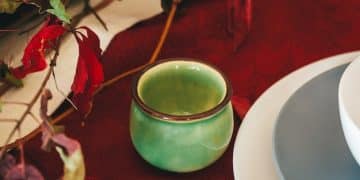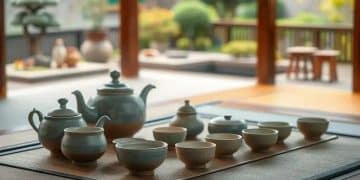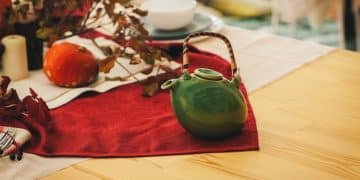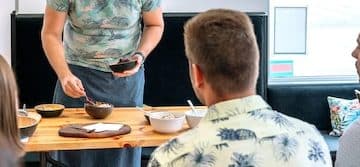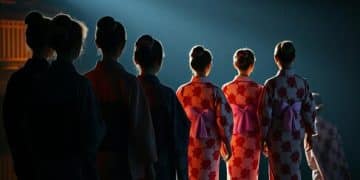Korean Tea Ceremony Etiquette: A Beginner’s Guide for US Participants
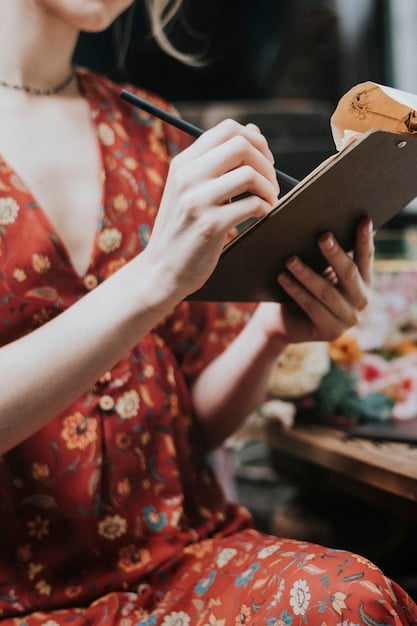
Korean Tea Ceremony Etiquette: A Beginner’s Guide for US Participants offers a comprehensive introduction to the traditions and customs of Korean tea ceremonies, specifically tailored for individuals in the US who are interested in participating or learning more about this cultural practice.
The allure of Korean culture has captivated the world, thanks in part to the popularity of K-dramas and K-pop. For those in the US eager to immerse themselves further, understanding the nuances of Korean traditions is essential. Among these, the **Korean Tea Ceremony Etiquette: A Beginner’s Guide for US Participants** provides a gateway into a world of profound respect, mindfulness, and cultural significance.
Understanding the Korean Tea Ceremony
The Korean tea ceremony, known as “darye” (茶禮) in Korean, is a beautiful and intricate tradition that involves the preparation and drinking of tea. It’s more than just a simple tea break; it’s a ritual deeply rooted in Korean history, philosophy, and etiquette. Understanding its significance is the first step in appreciating and participating respectfully. For US participants, grasping the fundamentals of darye etiquette is crucial before attending or hosting such an event.
Historical and Cultural Significance
Darye has its roots in ancient Korean culture, dating back to the Three Kingdoms period. It was initially practiced among the aristocracy and Buddhist monks, gradually spreading to the common people. The ceremony reflects Confucian values such as respect for elders, harmony, and mindfulness. By understanding this historical context, participants can better appreciate the depth and intention behind each action in the ceremony.
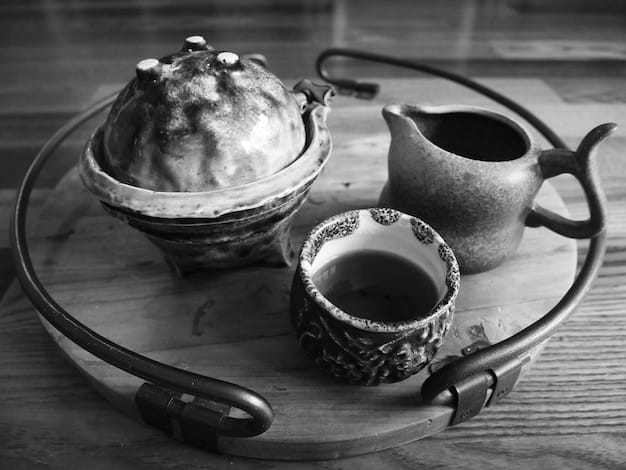
The Philosophy Behind Darye
The Korean tea ceremony is not just about drinking tea; it is a practice that encourages mindfulness and meditation. The act of preparing and serving tea with deliberate care fosters a sense of tranquility and presence. Participants are encouraged to appreciate the moment and engage in meaningful conversation. By embracing these philosophical underpinnings, US participants can enrich their experience and connect with the essence of darye.
- Respect for Elders: Serving tea to elders first is a sign of respect and deference, a core Confucian value.
- Harmony and Balance: The ceremony aims to create a harmonious environment, emphasizing balance in all aspects of life.
- Mindfulness: Being present in the moment and appreciating the simple act of drinking tea is a key element of darye.
- Hospitality: Offering tea is a gesture of welcoming and showing kindness to guests, fostering strong relationships.
By understanding the historical, cultural, and philosophical aspects of the Korean tea ceremony, US participants can approach the tradition with reverence and a deeper sense of appreciation. This foundational knowledge sets the stage for a more meaningful and enriching experience.
Key Elements of Darye Etiquette
Navigating the Korean tea ceremony requires an understanding of its key elements. From the attire worn to the specific gestures and words used, each aspect of the ceremony holds significance. Familiarizing yourself with these elements will ensure your participation is respectful and appreciated.
Attire and Appearance
Traditionally, participants in a Korean tea ceremony wear a hanbok, the traditional Korean dress. However, modern ceremonies may be less formal. In most cases, it’s important to dress modestly and respectfully. Clean and neat clothing is essential, avoiding any attire that might be considered distracting or disrespectful. For US participants, it’s always a good idea to inquire about the dress code beforehand to ensure they are appropriately attired.
Proper Posture and Demeanor
Maintaining proper posture and demeanor is crucial during the ceremony. Sit upright with your back straight and avoid fidgeting or slouching. Speak in a calm and respectful tone, and avoid loud or boisterous behavior. Showing reverence through your posture and demeanor demonstrates respect for the ceremony and its participants.
- Sit Upright: Maintain good posture to show respect and attentiveness.
- Speak Calmly: Use a quiet and respectful tone of voice.
- Avoid Fidgeting: Minimize unnecessary movements or distractions.
- Show Reverence: Demonstrate respect through your overall demeanor.
Mastering the essential elements of darye etiquette—from attire to posture—will allow US participants to fully engage in the ceremony while demonstrating respect and appreciation for Korean culture. These guidelines ensure a harmonious and meaningful experience for everyone involved.
Essential Phrases and Gestures
Communication in the Korean tea ceremony extends beyond words. Specific phrases and gestures play a vital role in expressing respect, gratitude, and hospitality. Understanding these nuances can greatly enhance your experience and demonstrate your awareness of Korean customs. Knowing when and how to use these phrases and gestures is key to a respectful participation.
Greeting and Introduction Phrases
Upon entering the tea ceremony setting, it’s important to greet the host and other participants with appropriate phrases. A simple “Annyeonghaseyo” (안녕하세요), which means “Hello,” is a polite way to start. When introduced, it’s customary to bow slightly as a sign of respect. Using honorific language shows deference to elders and those in positions of authority. Being prepared with these basic phrases can help US participants make a positive first impression.
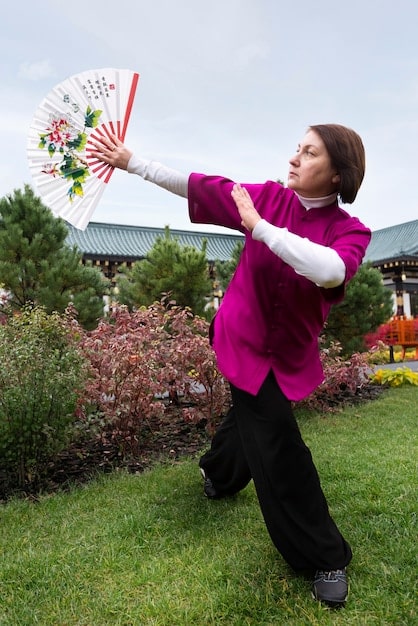
Serving and Receiving Tea
When serving tea, hold the teapot with both hands as a sign of respect. Pour the tea slowly and carefully, ensuring no spills. When receiving tea, accept the cup with both hands, and express gratitude by saying “Gamsahamnida” (감사합니다), which means “Thank you.” Take small sips, and avoid making loud noises while drinking. These gestures and phrases are integral to the etiquette of the ceremony.
- “Annyeonghaseyo” (안녕하세요): A polite greeting meaning “Hello.”
- “Gamsahamnida” (감사합니다): Expressing gratitude, meaning “Thank you.”
- Hold Teapot with Both Hands: A sign of respect when serving tea.
- Accept Cup with Both Hands: Showing appreciation when receiving tea.
By familiarizing themselves with essential phrases and gestures, US participants can navigate the Korean tea ceremony with confidence and demonstrate respect for Korean customs. These communication skills enhance the overall experience, fostering a deeper connection with the tradition.
Navigating Common Darye Scenarios
Participating in a Korean tea ceremony involves various scenarios, each requiring specific etiquette. Understanding how to navigate these situations ensures a smooth and respectful experience. From entering the tea room to engaging in conversation, being prepared can make all the difference. This section aims to equip US participants with the knowledge to handle common darye scenarios with grace.
Entering and Exiting the Tea Room
When entering the tea room, it’s customary to remove your shoes and place them neatly outside. Avoid stepping on the threshold, as it is considered disrespectful. Upon entering, greet the host and other participants with a bow. When exiting, do so quietly and respectfully, ensuring you leave the space as you found it. These practices show consideration for the environment and uphold traditional norms.
Participating in Conversation
During the tea ceremony, engaging in conversation is encouraged, but it should be done thoughtfully and respectfully. Avoid controversial or sensitive topics, and instead focus on light and positive subjects. Listen attentively when others are speaking, and avoid interrupting. Sharing your thoughts and experiences can foster a sense of connection, but always maintain a respectful and courteous tone.
- Remove Shoes: Place them neatly outside the tea room.
- Avoid Threshold: Do not step on the threshold when entering.
- Listen Attentively: Show respect by carefully listening to others.
- Engage Respectfully: Focus on light and positive conversation topics.
By understanding how to navigate common darye scenarios, US participants can move through the ceremony with confidence, demonstrating their respect for Korean traditions. These guidelines ensure a harmonious and enjoyable experience for everyone involved.
Understanding the Types of Tea Served
The type of tea served in a Korean tea ceremony is not arbitrary; each variety holds its own significance and is carefully selected based on the occasion and the preferences of the host. Understanding the different types of tea and their unique characteristics can enhance your appreciation for the ceremony. This knowledge adds another layer of depth to the experience.
Green Tea (Nokcha)
Green tea, known as “nokcha” (녹차) in Korean, is one of the most common types of tea served in darye. It is prized for its refreshing taste and health benefits. The tea leaves are typically harvested in the spring and processed minimally to preserve their natural flavors and antioxidants. Green tea is often served during formal ceremonies and is considered a symbol of purity and tranquility. Recognizing its qualities helps deepen the understanding of the event.
Roasted Rice Tea (Hyeonmi Cha)
Roasted rice tea, or “hyeonmi cha” (현미차), is another popular choice in Korean tea ceremonies. This tea is made from roasted brown rice, which gives it a nutty and slightly sweet flavor. It is often served during less formal gatherings and is appreciated for its warming and comforting properties. Hyeonmi cha is a versatile and approachable tea that appeals to a wide range of palates.
- Nokcha (녹차): Green tea, prized for its refreshing taste and health benefits.
- Hyeonmi Cha (현미차): Roasted rice tea, known for its nutty and comforting flavor.
- Chrysanthemum Tea: Made from dried chrysanthemum flowers, known for its floral aroma and flavor.
- Barley Tea: A common and refreshing tea made from roasted barley, often served cold in the summer.
By understanding the types of tea served in Korean tea ceremonies, US participants can appreciate the thoughtfulness and intention behind each selection. This knowledge enhances the overall experience and fosters a deeper connection with Korean culture.
Adapting to Regional Variations in Darye
The Korean tea ceremony is a tradition with deep roots, but it also exhibits regional variations. These differences can include the type of tea served, the specific rituals performed, and the attire worn. Being aware of these variations can help US participants adapt to different darye settings. Sensitivity to these nuances demonstrates respect for local customs.
Royal Court Tea Ceremony
The Royal Court Tea Ceremony, or “gungjung darye” (궁중다례), is a formal and elaborate tradition that was once performed for the Korean royal family. This ceremony involves intricate rituals, specific attire, and the use of high-quality teas. It is a symbol of prestige and is often performed on special occasions. Understanding its historical significance can provide valuable insight into Korean culture.
Family Tea Ceremony
The Family Tea Ceremony is a more informal and intimate gathering that is typically held to honor ancestors and celebrate important family events. This ceremony may involve simpler rituals and the use of everyday tea sets. It is an opportunity for family members to connect and strengthen their bonds. The atmosphere is often relaxed and convivial.
- Gungjung Darye (궁중다례): Formal Royal Court Tea Ceremony.
- Family Tea Ceremony: Informal gathering for family events.
- Variations in Tea: Regional preferences for different types of tea.
- Attire Differences: Variations in traditional clothing based on region or occasion.
By appreciating regional variations in darye, US participants can approach each ceremony with an open mind and a deeper understanding of Korean culture. This adaptability ensures a respectful and enriching experience, no matter the setting.
| Key Point | Brief Description |
|---|---|
| 🍵 Darye Etiquette | Essential for respectful participation in Korean tea ceremonies. |
| 🎎 Attire | Dress modestly; hanbok is traditional, but clean, neat clothing is sufficient. |
| 🗣️ Phrases | Use “Annyeonghaseyo” for greeting and “Gamsahamnida” for thanking. |
| 🍵 Tea Types | Green tea (Nokcha) and roasted rice tea (Hyeonmi Cha) are common choices. |
Frequently Asked Questions
▼
The Korean Tea Ceremony, or Darye, is a traditional practice rooted in Korean history and philosophy, emphasizing mindfulness, respect, and harmony through the preparation and consumption of tea.
▼
Traditionally, a Hanbok is worn, but modern ceremonies may be less formal. Clean, modest clothing is essential, showing respect for the tradition and participants in the ceremony.
▼
Knowing “Annyeonghaseyo” (Hello) for greetings and “Gamsahamnida” (Thank you) for expressing gratitude is key to showing respect and appreciation during the ceremony.
▼
Receive the tea cup with both hands as a sign of respect and gratitude. Take small sips quietly and avoid any loud noises, demonstrating attentiveness during the ceremony.
▼
Yes, ceremonies range from formal Royal Court Tea Ceremonies to informal family gatherings, each with unique rituals, attire, and tea selections based on the occasion.
Conclusion
Understanding and appreciating the nuances of Korean Tea Ceremony Etiquette is essential for US participants seeking to engage respectfully with this beautiful tradition. By familiarizing yourself with the history, key elements, essential phrases, and potential scenarios, you can participate with confidence and demonstrate your appreciation for Korean culture, enhancing your experience and fostering meaningful connections.

